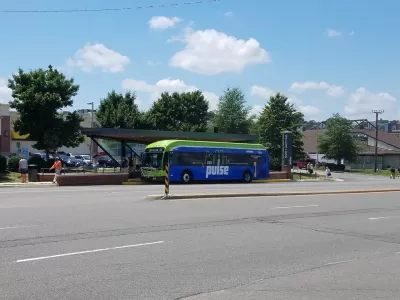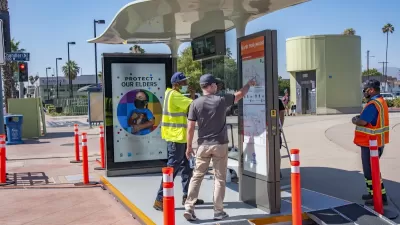The region’s transit agency plans to install new benches and shelters at as many as 75 percent of bus stops systemwide.

The Greater Richmond Transit Company (GRTC) has released a plan to add benches and shelters to some of its 1,609 bus stops, only 21 percent of which currently have a bench. As Wyatt Gordon writes in Greater Greater Washington, “According to the newly passed Essential Infrastructure Plan, starting next summer GRTC will begin installing 160 shelters and 225 benches over the next five years.”
Gordon notes that the agency would only reach 75 percent coverage with benches or shelters in their “aspirational” scenario, while the “attainable” plan would provide infrastructure at 50 percent of the system’s stops. “One of the biggest barriers to building out benches and shelters across the region was lifted earlier this year when the Virginia Department of Transportation finally approved GRTC’s proposed shelter style after an inexplicable two year plus delay.”
The project was prompted by the superior infrastructure provided along the Pulse bus rapid transit line, which led transit riders to demand similar improvements across the entire system—as Gordon puts it, “raised the bar on what many of the region’s residents consider acceptable stop infrastructure.”
Like other systems seeking to boost lagging ridership and ease the financial burden for its riders, the GRTC system went fare-free in 2020 and has extended free fares through June 2025.
FULL STORY: Shelters and benches for 75% of Richmond’s 1,609 bus stops? GRTC has a plan for that.

Study: Maui’s Plan to Convert Vacation Rentals to Long-Term Housing Could Cause Nearly $1 Billion Economic Loss
The plan would reduce visitor accommodation by 25,% resulting in 1,900 jobs lost.

North Texas Transit Leaders Tout Benefits of TOD for Growing Region
At a summit focused on transit-oriented development, policymakers discussed how North Texas’ expanded light rail system can serve as a tool for economic growth.

Using Old Oil and Gas Wells for Green Energy Storage
Penn State researchers have found that repurposing abandoned oil and gas wells for geothermal-assisted compressed-air energy storage can boost efficiency, reduce environmental risks, and support clean energy and job transitions.

Private Donations Propel Early Restoration of Palisades Playground
Los Angeles has secured over $1.3 million in private funding to restore the Pacific Palisades playground months ahead of schedule, creating a modern, accessible space that supports community healing after recent wildfires.

From Blight to Benefit: Early Results From California’s Equitable Cleanup Program
The Equitable Community Revitalization Grant (ECRG) program is reshaping brownfield redevelopment by prioritizing projects in low-income and environmental justice communities, emphasizing equity, transparency, and community benefits.

Planting Relief: Tackling Las Vegas Heat One Tree at a Time
Nevada Plants, a Las Vegas-based nonprofit, is combating the city’s extreme urban heat by giving away trees to residents in underserved neighborhoods, promoting shade, sustainability, and community health.
Urban Design for Planners 1: Software Tools
This six-course series explores essential urban design concepts using open source software and equips planners with the tools they need to participate fully in the urban design process.
Planning for Universal Design
Learn the tools for implementing Universal Design in planning regulations.
Ascent Environmental
Borough of Carlisle
Institute for Housing and Urban Development Studies (IHS)
City of Grandview
Harvard GSD Executive Education
Toledo-Lucas County Plan Commissions
Salt Lake City
NYU Wagner Graduate School of Public Service





























